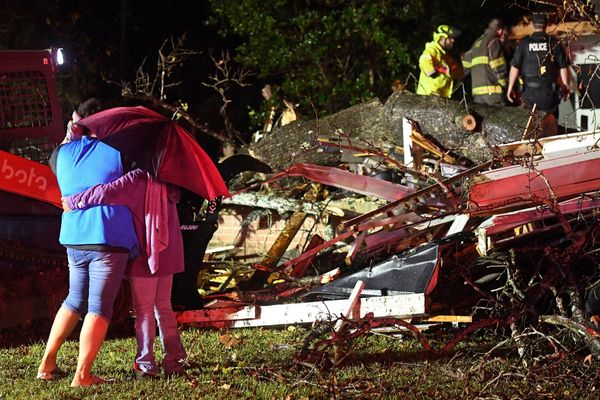Firefighters are being forced to adapt to changing bushfire behaviour, as relentless winds and dry conditions mean they have less reprieve at night to get on top of out-of-control blazes.
Senior firefighters have noticed this pattern emerging at bushfires over the last few years and are recalibrating both mitigation strategies and the way fires are being fought.
Historically, firefighters have been able to take advantage of cooler night-time conditions when there is more moisture in the air to try to put in containment lines and other control measures.
"The difference now is we're not getting any reprieve overnight," WA Department of Fire and Emergency Services (DFES) deputy commissioner of operations Craig Waters said.
"We've had a soil moisture deficit and I think that's come to play in the evening hours. We've seen massive runs with high winds. Extremely dry conditions, low humidity levels, which is basically caused catastrophic fire conditions and escalating the rate of spread through those areas."
The 2015 Northcliffe fire doubled in size overnight, the 2019-20 Yanchep fire also doubled, while Mr Waters said the "extreme conditions" of February's Wooroloo blaze that destroyed 86 homes saw it triple in size overnight.
The Wooroloo fire had an extremely low dew point, the temperature to which air must cool to form dew, of minus five degrees Celsius.
"To get down to -5C is unprecedented," Mr Waters said.
"It just highlights the extremely dry conditions firefighters had to confront during the evenings of those fires."
Impact seen in Esperance as climate debate rages
They are the sort of conditions Cascade grain farmer and firefighter Will Carmody has experienced while tackling fires in the Esperance area, on WA's south coast.
"In the last few years we've certainly had that same sort of experience, that the fires certainly do just keep going at night, and you've got to be extremely careful when you're doing some of these control methods in fighting a fire," Mr Carmody said during a break from tackling a blaze in Munglinup, about 100 kilometres west of Esperance.
"It makes it a lot more difficult to put in a back-burn [because] the back-burn could get away."
The Bureau of Metereology and the CSIRO both say climate change has led to longer bushfire seasons and an increase in the average number of high-risk fire days.
Not everyone agrees, though.
"There is nothing unprecedented about intense and serious bushfire behaviour today," said retired firefighter Roger Underwood, from bushfire management advocacy group Bushfire Front.
In his submission to the inquiry into the Wooroloo bushfire, he said there was nothing new about the weather conditions at the time.
He said the strong, dry, easterly winds combined with a cyclone in the north of the state were the sort of weather patterns that happened almost every summer in WA.
"We regard blaming a bushfire on 'climate change' as an excuse for failed land and bushfire management," his submission stated.
More resources to fight fires: DFES
But DFES is already responding to changing fire behaviour and longer fire seasons.
Firefighters are trying to hit fires fast and hard with more resources to keep them from running.
"We get a lot more resources in a timely fashion to the fire ground," Mr Waters said.
"We stand up a lot of resources on stand-by in preparation to respond. They're strategically located in high-risk areas, around not only the metropolitan area but also pre-deployed to other areas of the state that may pose a high-risk level of bushfires. We stand up additional aircraft."
At Woorooloo, large air tankers were used to lay retardant lines, which DFES credited with saving Shady Hills estate in Bullsbrook.
But the strategy did not stop the overall blaze from running ferociously out of control, with the wind blowing embers 2 to 3 kilometres ahead of the front.
"Catastrophic conditions, there's some occasions where you're just not going to pull fires up," Mr Waters said.
That makes mitigation measures, such as planned burns, even more important.
Bigger focus on planned burns
On Perth's Darling Scarp, veteran firefighter Rod Wallington and his team are keeping a close eye on the thick bushland of the Ellis Brook Valley reserve.
"It's quite a deep valley and steep terrain either side with very limited access for our fire crews, so if a fire was to start here it would be very difficult to access and contain," said Mr Wallington, the emergency operations officer for the City of Gosnells.
They try to have planned burns ready to go whenever the conditions are right.
"The forest recovers quite well from a planned burn," Mr Wallington said.
"It will still carry a fire in summer, but at this time of the year, a fire will slow down in this sort of fuel load rather than continue on."
Firefiighters are increasingly looking beyond late winter and spring for planned burns, taking their opportunities whenever they can.
DFES executive director of rural fire, Murray Carter, said authorities could not control weather or climate, but they could control fuel loads.
"The more of it you can do and the more targeted you can become, it's probably one of best preparations you can make in terms of keeping the Western Australian community safe," Mr Carter said.
"Maybe we get in there early June to July when the seasons vary somewhat. We've just got to look for greater opportunity."
Property owners also had a responsibility to reduce fuel loads.
"If you own the fuel, you know, then you own the risk and need to do something about it," Mr Carter said.







